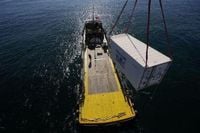In a remarkable breakthrough that could reshape the world’s approach to water scarcity, scientists have successfully extracted samples of fresh water from massive reservoirs hidden deep beneath the ocean floor. The first-of-its-kind drilling operation, revealed to the public on September 5, 2025, has sparked hope among experts and communities grappling with dwindling freshwater supplies.
According to reports published on September 5, 2025, researchers embarked on this unprecedented mission with one ambitious goal: to confirm the existence and accessibility of vast, untapped fresh water reserves lying below the seabed. The operation, described as the first of its kind, involved advanced drilling technology capable of reaching and safely extracting water from these secret underwater reservoirs.
This discovery, long theorized by oceanographers and hydrologists, could not have come at a more critical time. As populations grow and climate change intensifies droughts and depletes traditional water sources, the need for alternative freshwater supplies has never been more urgent. The news, first reported by several outlets, has quickly traveled across scientific and policy-making circles, igniting a wave of optimism and debate about the future of global water resources.
So, how did scientists manage to tap into these elusive reserves? The process began with years of research and mapping, as teams used seismic imaging and other geophysical tools to identify likely locations where fresh water might be trapped beneath layers of sediment and rock. Once a promising site was selected, the drilling team deployed specialized equipment designed to withstand the immense pressures and challenging conditions of the deep ocean environment.
When the drill finally reached its target, the team was able to extract samples of fresh water—clean and surprisingly abundant—from beneath the ocean floor. According to the scientists involved, this was a moment of both relief and exhilaration. "It was like striking liquid gold," one researcher was quoted as saying, capturing the sense of excitement that swept through the operation.
The implications of this discovery are profound. For decades, scientists have speculated about the existence of so-called "submarine groundwater reserves"—pockets of fresh water that formed thousands, or even millions, of years ago, when sea levels were lower and rainwater seeped into porous rocks along ancient coastlines. Over time, these reserves became trapped as the oceans rose, sealing them off from contamination and evaporation.
Now, with the successful extraction of fresh water samples, those theories have been confirmed. As noted in the September 5, 2025, reports, the reservoirs are not only real but may be far more extensive than previously thought. Early estimates suggest that the volume of fresh water stored beneath the oceans could rival or even exceed the reserves found in some of the world’s largest lakes and rivers.
This news has raised hopes for a thirsty world, especially in regions where traditional sources of fresh water are under severe stress. Drought-prone countries, coastal cities facing saltwater intrusion, and island nations with limited rainfall all stand to benefit from new technologies that could tap into these hidden reserves.
However, the path from scientific discovery to practical solution is rarely straightforward. Experts caution that while the existence of undersea fresh water is now confirmed, significant challenges remain before it can be harnessed on a large scale. Drilling beneath the ocean floor is technically demanding and expensive, and questions about the environmental impact of such operations must be carefully addressed.
Moreover, there are concerns about the sustainability of extracting water from these ancient reserves. Unlike rivers or lakes that are replenished by rainfall, undersea aquifers may take millennia to recharge. "We have to be extremely careful not to treat these reserves as an infinite resource," warned one hydrologist familiar with the project. "If we draw too much, too quickly, we could exhaust them before we even understand their full extent or ecological importance."
Despite these caveats, the mood among scientists and policymakers is one of cautious optimism. The breakthrough drilling operation has opened the door to new research collaborations, with teams from around the world eager to map additional reservoirs and develop safer, more efficient extraction methods.
Some experts are already envisioning a future in which coastal cities could supplement their water supplies with fresh water drawn from beneath the sea, reducing their reliance on desalination plants or long-distance pipelines. Others see potential for emergency relief in drought-stricken regions, where rapid deployment of drilling rigs could provide a lifeline during times of crisis.
According to the reports published on September 5, 2025, the announcement has also caught the attention of international organizations focused on water security and climate resilience. The United Nations and World Bank have both expressed interest in funding further research, viewing undersea fresh water as a potential game-changer in the fight against water scarcity.
Of course, not everyone is convinced that this new frontier will solve the world’s water woes. Environmental groups have urged caution, pointing out that large-scale drilling could disrupt fragile marine ecosystems or inadvertently trigger leaks of salt water into the fresh water reservoirs. Some policy analysts have also raised questions about ownership and access, warning that disputes over undersea resources could spark new geopolitical tensions.
Still, the sheer scale of the discovery has left many hopeful that science and technology can offer fresh answers to one of humanity’s oldest challenges. As one project leader remarked, "We’re standing at the threshold of a new era in water exploration. There’s still so much to learn, but for the first time, we know these reserves are real—and that changes everything."
As researchers analyze the extracted samples and plan the next phase of exploration, the world will be watching closely. The promise of fresh water beneath the waves is no longer just a scientific curiosity—it’s a potential lifeline for billions of people facing a future defined by scarcity and change.
With the first samples in hand and the world’s attention focused on the ocean’s hidden depths, the conversation about water security has taken an unexpected and hopeful turn. The coming years will determine whether this breakthrough leads to sustainable solutions or simply sparks more questions, but for now, the discovery stands as a testament to human ingenuity and the enduring quest for survival in a changing world.




